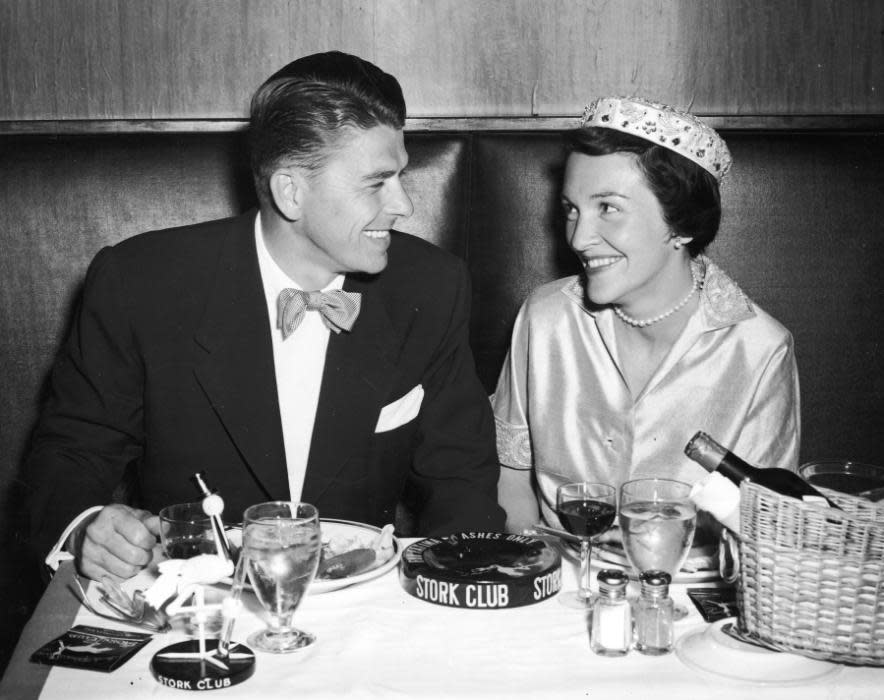Nancy Reagan owned her role as the woman behind the man
It was known as “the Gaze” — the look Nancy Reagan would give her husband as she watched him speak in public. A mix of adoration and reverence with a touch of schoolgirl crush, the Gaze reflected a moment in the history of this country, and in the role of the first lady.
“She totally saw her role as supporting and defending her husband,” says Mary Beth Durkin, whose documentary “Nancy Reagan: The Role of a Lifetime” premiered in 2011 on PBS. “And in protecting him she became one of the most powerful first ladies ever.”
Married in 1952 — it was his second marriage, her first — the Reagans were old-fashioned even for their time. As Ronald Reagan’s biographer Edmund Morris told NPR upon Nancy’s death Sunday morning at the age of 94, “Nancy loved Ronald Reagan with a consuming passion. He was her one and only reason for existence.”
Slideshow: Nancy Reagan — a look back >>>
Friends and observers of the couple were struck over the decades by the all-consuming nature of the Reagans’ relationship. They were not just a partnership as much as a fusing of two into one. Theirs was so insular and singular a bond that even their children seemed pushed outside the circle.
“A codependency,” Durkin calls it. “An emotional unit unto themselves.”
Nancy Reagan often said that her life began the day she married Ronald. It was a way of looking at marriage that would become increasingly quaint during the 1960s and ’70s, as feminism redefined the role of women. During Reagan’s years as governor from 1967 to 1975, working mothers became the norm, divorce rates spiked and first ladies became independent and opinionated. Betty Ford was an outspoken feminist, supporting the Equal Rights Amendment and abortion rights. Rosalyn Carter sat in on Cabinet meetings and led diplomatic missions.

Nancy and Ronald Reagan at their Santa Barbara ranch. (Photo: Mary Anne Fackelman-Miner/White House/The LIFE Picture Collection/Getty Images)
Cultural change is rarely linear, and by the time the Reagans displaced the Carters from the White House in 1980, the retro feel of their marriage appealed to a new wave of conservatives who aimed to protect the traditional ways they feared were disappearing. And Nancy Reagan certainly did act the part of a woman who stood by her man. But cultural change can also be much more complicated than it at first appears, and in the end, the most traditional of the post-Second Wave feminism first ladies would turn their devotion into a unique kind of power.
Slideshow: Saying goodbye to Nancy Reagan >>>
From where she stood, Nancy was only and always protecting her husband. That is why she redecorated the White House and bought new china — acts that were criticized as tone deaf in a recession — because “Ronnie’s” home must be comfortable and his office worthy. It was, she told Fresh Air host Terry Gross years later, why she turned to astrology to determine the presidential calendar after a 1981 attempt on his life. “When a friend called me and said I know this lady who said that if she only could have gotten to you, she could have told you that he shouldn’t have done anything that day,” Nancy said, “and I thought, ‘Oh my Lord, I could have saved him maybe.’”

Hollywood actor Ronald Reagan and his wife, Nancy, have their honeymoon dinner at the Stork Club, New York City, 1952. (Photo: Hulton Archive/Getty Images)
Nancy Reagan had political instincts that her husband didn’t, her biographers say. “He was affable to everyone and he couldn’t suss out who was gaming him,” Durkin says. “On the other hand, she was shrewd and her ‘people radar’ was so keen that she was always on the watch for someone trying to take advantage.”
Related video: The epic love story of Ronald and Nancy Reagan
Reagan biographer Morris agrees: “He needed a screen, a protector. That’s the only real political function she formed for him. She could see a predator coming from a mile off.”
When she thought someone was not helping the man she loved, Nancy Reagan took action. She is credited with the ouster of Donald Regan as her husband’s chief of staff in 1985 because she didn’t think he was doing enough to stop public criticism of her husband during the Iran-Contra scandal.

The iconic presidential couple. (Photo: Ronald Reagan Presidential Library/Getty Images)
In this way, though the Reagans marked the end of an era in terms of what people expect from a presidential marriage, they also marked the start of what they will accept in a first lady. From that administration forward, it was more accepted that presidential wives were powerful figures with real political clout. Nancy’s time in the White House also hardened public suspicion of spouses who dare to use that clout, a pushback felt particularly keenly by Hillary Clinton, when she was put in charge of health care reform during her husband’s presidency, and by Michelle Obama, whose critics accuse her of wanting to control what Americans eat.
“Her influence was stealth,” Durkin says of Reagan. “She gazed adoringly, and in doing so, she changed the role well beyond her own time.“

